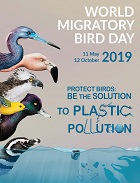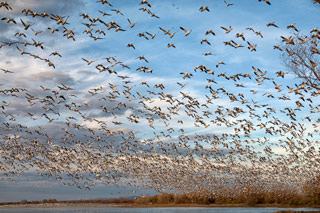World Migratory Bird Day
World Migratory Bird Day
 The International Migratory Bird Day was created in 1993 by the visionaries at the Smithsonian Migratory Bird Centre and the Cornell Laboratory of Ornithology. Acting on the initiative to create awareness on conserving birds and their habitat throughout the Western Hemisphere, this programme gave rise to the ‘World Migratory Day’ in 2006, which was proposed by the United Nations.
The International Migratory Bird Day was created in 1993 by the visionaries at the Smithsonian Migratory Bird Centre and the Cornell Laboratory of Ornithology. Acting on the initiative to create awareness on conserving birds and their habitat throughout the Western Hemisphere, this programme gave rise to the ‘World Migratory Day’ in 2006, which was proposed by the United Nations. The World Migratory Bird Day is held on the second Saturday of May and the second Saturday of October every year as an effort of the United Nation’s Agreement on the Conservation African-Eurasian Migratory Waterbirds and depending on the season when the birds will be migrating to a particular place. In India, the World Migratory Bird Day falls on the second Saturday of May as this is the season when people get to watch birds migrating. Each year the World Migratory Day presents an annual theme to raise awareness on issues affecting migratory birds and to inspire both people and organisations around the world to take the necessary measures for their conservation.
The theme of the World Migratory Bird Day of 2019 is "Protect Birds: Be the Solution to Plastic Pollution!". With an annual production of more than 300 million tons of plastic each year, plastic often used and discarded in the ecosystem can cause serious threats to organisms around the world. Due to it is lightweight and durability, plastic whose purpose is for a moment can last up to 500 years. Plastic is often consumed by birds which get entangled in their stomachs and causes plastic rings that ultimately smothers them to death.
 Plastic also proves to be a potential danger to humans where they can leech out chemicals and other toxins into the food served which causes birth defects, cancer and other impairments. Plastic pollutes groundwater and causes pollution when they are burnt. Lastly, plastic also destroys ecosystems, pollutes water bodies and can cause serious damage to the nature.
Plastic also proves to be a potential danger to humans where they can leech out chemicals and other toxins into the food served which causes birth defects, cancer and other impairments. Plastic pollutes groundwater and causes pollution when they are burnt. Lastly, plastic also destroys ecosystems, pollutes water bodies and can cause serious damage to the nature. The key to prevent this mass scale problem, it is essential to educate and sensitise students on the dangers of plastic. The lives of several birds, animals and plants solely depend on reducing the large-scale usage of plastic. Here are some of the ways by which teachers can encourage their students to reduce the use of plastic-
-
Educate the students to limit the use of plastic and recycle its components to reduce their impact. Encourage them to opt for green bags or jute bags as they are eco-friendly in nature and can be used more than once.
-
Sensitise the students to be aware of the ill effects of plastic and encourage them to organise campaigns to inform the public with the use of posters and short skits.
-
Discourage the dumping of waste in plastic bags, in public places where animals can easily gain access to them.
-
Opt for the correct method of disposing plastic bags and other plastic components.
 The events of the World Migratory Bird Day include birdwatching, studying the habitat of birds and other activities relating to birds. Over 750 events are organised such as birdwatching hikes, festivals, movie screenings, talks and presentations across 80 countries across the globe. Here is how World Migratory Bird Day can be celebrated in schools-
The events of the World Migratory Bird Day include birdwatching, studying the habitat of birds and other activities relating to birds. Over 750 events are organised such as birdwatching hikes, festivals, movie screenings, talks and presentations across 80 countries across the globe. Here is how World Migratory Bird Day can be celebrated in schools--
To educate the students on various bird species and their habitats, teachers can organise a field trip for the students where they can visit a bird sanctuary/zoo.
-
Encourage the students to create small nests made up of twigs, paper scraps, and cotton so that smaller birds who are nesting will be benefitted by these nests.
-
Educate students to place small pots of water at their home’s terraces, balconies and other outdoor areas where birds which feel thirsty can be benefitted.
-
Teachers can talk and discuss the various migratory species of birds to get the students to learn more. They can also discuss ways on how endangered species of birds must be protected.
-
Teachers can spark their students’ interest in ornithology (the study of birds) by encouraging them to buy a pair of binoculars and to observe various species of birds found in their neighbourhood. They can also encourage students to maintain a log book for the birds observed and encourage them to share their observations with the class.





















